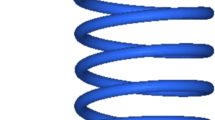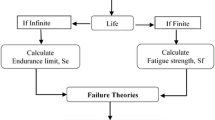Abstract
High supersonic vehicles are exposed to high temperature generated by aerodynamic heating. Thermal protection system structures are used on the skin of the fuselage and wings to prevent the transfer of high temperatures into the interior of the vehicle. Thin skin panels can be exposed to acoustic loads by high power engine noise and jet flow noise, which can cause sonic fatigue damage. Therefore, it is necessary to examine the behavior of supersonic/hypersonic vehicle skin structures under thermal-acoustic loads and to predict fatigue life. In this paper, thermal-acoustic testing of titanium specimens under thermal-acoustic load was performed. The response stress history of the specimen was obtained, and the fatigue life was predicted using the time and frequency domain fatigue life prediction method. The effect of the mean stress on the predicted results of the time and frequency domian fatigue life was analyzed. Stress history was generated using a sine series of random phases from stress PSD without phase information. The fatigue life in the generated stress history was predicted using the time and frequency domain fatigue life prediction methods. As the temperature increased, the mean stress of the response stress and the error in the frequency domain fatigue life prediction results increased. The error in the frequency domain fatigue life prediction results with the mean stress effect were greatly reduced by considering the completely reversed stress.
Similar content being viewed by others
Abbreviations
- a(k):
-
Best fitting parameters (Wirsching Light)
- b :
-
Benasciutti Tovo method parameter
- b(k):
-
Best fitting parameters (Wirsching Light)
- C :
-
S-N curve coefficient
- D :
-
Damage intensity
- f :
-
Frequency
- G 1 :
-
Dirlik method parameter
- G 2 :
-
Dirlik method parameter
- G 3 :
-
Dirlik method parameter
- K Gebber :
-
Gerber transformation coefficient
- K Goodman :
-
Goodman transformation coefficient
- k :
-
S-N slope coefficient
- m i :
-
i-th spectral moment
- \({N_{{f_i}}}\) :
-
i-th number of cycles to failure
- N i :
-
i-th number of cycles
- P DK :
-
Cycle amplitude probability density function (Dirlik)
- Q :
-
Dirlik method parameter
- R :
-
Dirlik method parameter
- S XX :
-
Power spectral density
- t :
-
Time
- Z :
-
Dirlik method parameter
- α i :
-
Irregularity factor
- Γ:
-
Euler gamma function
- ε :
-
Spectral width
- θ k :
-
Phase
- ν 0 :
-
Rate of zero crossings
- ν P :
-
Rate of peaks
- ρ WL :
-
Empirical correction factor (Wirsching Light)
- σ a :
-
Alternating stress
- σ cr :
-
Completely reversed stress
- σ m :
-
Mean stress
- σ u :
-
Ultimate strength
References
R. D. Blevins, D. Bofilios, I. Holehouse, V. W. Hwa, A. L. Laganelli, P. Pozefsky and M. Pierucci, Themo-vibro-acoustic loads and Fatigue of Hypersonic Flight Vehicle Structure, Goodrich Aerostructures Group, Final Report (2009).
T. Beier and P. Heaton, High Speed Research Program Sonic Fatigue Summary Report, The Boeing Company, St. Lousi, Missouri, USA (2005).
T. G. Eason and S. Spottswood, A structures perspective on the challenges associated with analyzing a reusable hypersonic platform, 54th AIAA/ASME/ASCE/AHS/ASC Structures, Structural Dynamics, and Materials Conference (2013) 1747.
J. B. Park, C. H. Kang, K. S. Kim, J. M. Choung and C. H. Yoo, A study on frequency domain fatigue damage prediction models for wide-banded bimodal stress range spectra, Journal of the Society of Naval Architects of Korea, 48 (4) (2011) 299–307.
B. L. Clarkson, Stresses in Skin Panels Subjected to Random Acoustic Loading, Technical Report, Institute of Sound and Vibration Research, Southampton University, United Kingdom (1967).
Y. Zhou, W. Wu, Z. Tan and Q. Fei, Temperature dependence of acoustic fatigue life for thermal protection structures, Theoretical and Applied Mechanics Letters, 4 (2) (2014).
N. E. Dowling, Fatigue failure predictions for complicated stress-strain histories, Journal Materials, 7 (1) (1972) 71–87.
ASTM E 1049-85, Standard Practices for Cycle Counting in Fatigue Analysis (2005).
N. W. M. Bishop, The use of frequency domain parameters to predict structural fatigue, Ph.D. Thesis, University of Warwick (1988).
M. Mršnik, J. Slavić and M. Boltežar, Frequency domain methods for a vibration-fatigue-life estimation-Application to real data, International Journal of Fatigue, 47 (2013) 8–17.
T. Irvine, Estimation Fatigue Damage from Stress Power Spectral Density Functions Revision A, Vibrationdata (2014).
P. H. Wirsching and M. C. Light, Fatigue under wide band random stresses, Journal of the Structural Division, 105 (7) (1980) 1593–1607.
D. Benasciutti, Fatigue analysis of random loadings, Ph.D. Thesis, University of Ferrara, Italy (2004).
T. Dirlik, Application of computers in fatigue analysis, Ph.D. Thesis, University of Warwick (1985).
R. Tovo, Cycle distribution and fatigue damage under broadband random loading, International Journal of Fatigue, 24 (11) (2002) 1137–1147.
D. Benasciutti and R. Tovo, Spectral methods for lifetime prediction under wide-band stationary random processes, International Journal of Fatigue, 27 (8) (2005) 867–877.
A. Niesłony and M. Böhm, Frequency-domain fatigue life estimation with mean stress correction, International Journal of Fatigue, 91 (2016) 373–381.
S. A. Rizzi and T. L. Turner, Enhanced capabilities of the NASA Langley thermal acoustic fatigue apparatus, Proceedings of the 6th International Conference on Recent Advances in Structural Dynamics, 2 (1997) 919–933.
J. F. Betts, Experimental Structural Dynamic Response of Plate Specimens due to Sonic Loads in a Progressive Wave Tube, NASA/CR-2001-211045 (2001).
J. Y. Kim, K. H. Kim and D. I. Kwon, Evaluation of high-temperature tensile properties of Ti-4Al-4V using instrumented indentation testing, Metals and Materials International, 20 (2) (2016) 209–215.
P. Mohanraj, S. Balaji and S. Senthikumar, Fatigue analysis in aircraft landing gear axle shaft to develop the life cycles, International Journal of Engineering Research & Technology, 2 (6) (2013) 2265–2272.
J. P. Quigley, Y. L. Lee and L. Wang, Review and assessment of frequency-based fatigue damage models, SAE International Journal of Materials and Manufacturing, 9 (3) (2016) 565–577.
Acknowledgments
This work was supported by the Agency for Defense Development (ADD-06-201-801-014), Republic of Korea.
Author information
Authors and Affiliations
Corresponding author
Additional information
Eun-Su Go is a Ph.D. student of Department of Aerospace Engineering, Chungnam National University, Daejeon, Republic of Korea. His research interests include impact behavior of composite materials, design and testing of composite structures, and thermal-acoustic fatigue life prediction of aircraft structures.
Mun-Guk Kim received his M.S. degree in Dept. of Aerospace Engineering, Chungnam National University, Daejeon, Republic of Korea. His research interests include pyroshock simulation test, impact behavior of composite materials, thermal-acoustic test, and design and testing of composite structures.
In-Gul Kim is a Professor of Department of Aerospace Engineering, Chungnam National University, Daejeon, Republic of Korea. He received his Ph.D. in Engineering Science & Mechanics from Pennsylvania State University. His research interests include impact behavior of composite materials, structural health monitoring, and design and testing of composite structures.
Min-Sung Kim is Principal Researcher of Aerospace Technology Research Institute, Agency for Defense Development, Daejeon, Republic of Korea. He received his Ph.D. in Aerospace and Mechanical Engineering from Korea Aerospace University. His research interests include smart skin structures, fatigue behavior of metal and composite materials, and analysis and testing of aircraft structures.
Rights and permissions
About this article
Cite this article
Go, ES., Kim, MG., Kim, IG. et al. Fatigue life prediction in frequency domain using thermal-acoustic loading test results of titanium specimen. J Mech Sci Technol 34, 4015–4024 (2020). https://doi.org/10.1007/s12206-020-2212-y
Received:
Revised:
Accepted:
Published:
Issue Date:
DOI: https://doi.org/10.1007/s12206-020-2212-y




